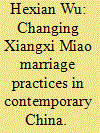| Srl | Item |
| 1 |
ID:
117934


|
|
|
|
|
| Publication |
2013.
|
| Summary/Abstract |
This essay describes elements of Xiangxi Miao marriage practices such as courtship, wedding ceremonies, and marriages between the Miao and Han, exploring how Xiangxi Miao marriage practices changed at the turn of this century, and disclosing social influences on the changes in marriage practices. The author uses a Miao village of Zalun as a case study. Through participant observation and intensive interviews, it was found that, before 2000, Xiangxi Miaos' courtship practices and wedding ceremonies had strict processes and reflected agricultural rhythm. In addition, there were few marriages between the Miao and Han. Since the beginning of this century, Xiangxi Miao marriage practices have changed due to socioeconomic development, population mobility, and diverse communication between Miao young women and men. Dramatic shifts in marriage practices have produced social influences among Xiangxi Miao communities. The changes in marriage practices have promoted Xiangxi Miao free marriages, advancing social cohesion and acculturation. However, these changes have also increased numbers of criminals and problems of healthy growth and education of the stay-at-home children.
|
|
|
|
|
|
|
|
|
|
|
|
|
|
|
|
| 2 |
ID:
163343


|
|
|
|
|
| Summary/Abstract |
Tibetan pastoralists have been subject to large-scale state-led development policies over the past three decades. The provisioning of institutionalized state schooling, in particular, has all along been part and parcel of these development projects, including urbanization and resettlement initiatives. However, for a variety of reasons, the promotion of schooling in Tibetan pastoral areas has been a challenge since the first Maoist efforts in 1950s. By focusing on a case study of a Buddhist monk’s persistent effort to build a primary school in his home village in the eastern region of Tibet in 1990, and on how Tibetan villagers’ views of him and his school project have changed over time, this paper examines the nexus of relationships between schooling, and social and cultural changes in pastoral Tibet. I also aim to relate Tibetan pastoralists’ shifting values of schooling to the larger social and political context, particularly the ubiquitous Chinese xiangmu (project) economy and Tibetan pastoralists’ ever-increasing dependence on the state. This paper argues that although state schooling is highly contested, it has been one of the driving forces of social change in Tibetan pastoral areas today.
|
|
|
|
|
|
|
|
|
|
|
|
|
|
|
|